Deixis
语用学之指示语

1
第二章 指示词语及其功能
• 什么叫指示词语 • 指示词语的指示用法 • 指示词语的类别 • 指示词语的功能 • 思考与分析
精选版课件ppt
2
一、什么叫指示词语
1、英语“deixis“的汉译
英语“deixis”一词来自希腊语,原意 为“指点(pointing)”或“标示 (indicating)”。
?泛珠三角?又叫?92?即珠江流域的广东广西福建江西海南湖南四川云南贵州9个省加上香港澳门两个特别行政区进行区域合作共谋经济发展?101?根据该语言环境很难推测因为它对应的是精确信息而非含糊指示78可见对于需要精确或准确信息时相关数字可能给读者带来一定的信息空缺造成理解障碍
第二章 指示词语及其功能
精选版课件ppt
精选版课件ppt
11
2、象征用法:
指在使用指示词语时仅需要知道言语 事件的基本的时间空间参数就可以理解的用 法。 (10)这所学校的环境真美。 (11)This city is beautiful.
只要知道(10)这句话是在武汉大学说 的,不论说话的具体地点在何处,“这所学 校”指的都是武汉大学。
精选版课件ppt
4
指示 词 语 包 括 : 指 示 代 词 、 人 称 代词、物主代词、时态助词、某些情态 助动词和表示移动的动词、时间和地点 副词、某些称谓,以及在特定语境中表 示事物关系和人的社交关系的词语。
精选版课件ppt
5
3、指示系统的组织方式 在面对面的言语交际中,指示系统一般是以自 我(说话人)为中心组织起来的。 指示语的指示中心: ①中心人物一般是说话人; ②中心时间是说话人说话的时间; ③中心地点是说话人说话时所处的地点; ④语篇中心是一句话中说话人当时正说到的部分; ⑤社交中心是说话人相对于说话对象的社会地位。
指示语deixis

指示语deixis话语中跟语境相联系的表示指示信息的词语,就叫做指示语。
指示是语用研究中一个重要概念,涉及到一些词语,如代词、称谓、时间处所词语等。
这些词语的具体或确切的指称意义,必须结合具体的语境,才能准确理解。
指示语主要有:1、人称指示。
称指示是话语中关于人物人称的指示。
最典型的是人称代词,又分第一人称指示、第二人称指示、第三人称指示。
2、时间指示。
时间指示是话语中关于时间的指示。
时间是一个抽象的概念,人们只能人为地选定一些参照点。
在言语交际中,时间指示是以说话时刻作为参照点来计算和理解的。
3、空间指示。
空间指示是话语中关于处所、方位的指示。
空间指示主要有:表示方位和处所的名词、副词、指示代词,具有位移意义的动词如“来”“去”“走”“离开”“到达”等。
4、话语指示。
话语指示又称语段指示、上下文指示,是用来指明话语中部分与部分之间关系的。
由于言语交际是在一定的时间、空间中展开的,所以话语指示与时间指示、空间指示有密切关系,有些时间指示、空间指示同时也是话语指示。
5、社交指示。
社交指示是用来指明发话人和受话人之间,或发话人跟所谈及的人(第三方、之间的社会关系的词语。
DeixisFrom Wikipedia, the free encyclopediaIn linguistics, deixis refers to the phenomenon wherein understanding the meaning of certain words and phrases in an utterance requires contextual information. Words are deictic if their semantic meaning is fixed but their denotational meaning varies depending on time and/or place. Words or phrases that require contextual information to convey any meaning - for example, English pronouns - are deictic. Deixis is closely related to both indexicality and anaphora, as will be further explained below. Although this article deals primarily with deixis in spoken language, the concepts can apply to written language, gestures, and communication media as well. And even though this article is primarily concerned with English, deixis is believed to be a feature (to some degree) of all natural languages.[1]The term’s origin is Ancient Greek: δεῖξις ""display, demonstration, or reference"", the meaning "point of reference" in contemporary linguistics having been taken over from Chrysippus.[2Types of deixis[edit]Traditional categoriesPossibly the most common categories of contextual information referred to by deixis are those of person, place, and time - what Fillmore calls the “major grammaticalized types” of deixis.[3] [edit]PersonPerson deixis concerns itself with the grammatical persons involved in an utterance, (1) those directly involved (e.g. the speaker, the addressee), (2) those not directly involved (e.g. overhearers—those who hear the utterance but who are not being directly addressed), and (3) those mentioned in the utterance.[4] In English, the distinctions are generally indicated by pronouns. The following examples show how. (The person deictic terms are in italics [a signaling notation that will continue through this article].)I am going to the movies.Would you like to have dinner?They tried to hurt me, but he came to the rescue.GenderIn many languages, that only have male and female, referring to gender neutral subjects has different aspects. Objects , or things have their own gender too between male or female. When referring to a genderless object, it is often referred to as a male, though the object is genderless. In the English language, when referring to any character that has no gender, a self-aware entity, it is referred to a male, or as a "He", such as an "it" is inappropriate when calling the sentient object a thing. In many languages, they would address to people as in male, such as a group mixed with men and women is referred to as a male, such as Ils in French. An example would be :A man is responsible for his own soulas opposed toEach person is responsible for his or her own soulcommon in many religious text referring to people of all genders using only the male gender. This can be understood in context, the male gender being used to signify male or female persons.PlacePlace deixis, also known as space deixis, concerns itself with the spatial locations relevant to an utterance. Similarly to person deixis, the locations may be either those of the speaker and addressee or those of persons or objects being referred to. The most salient English examples are the adverbs“here” and “there”and the demonstratives“this” and “that” - although those are far from being the only deictic words.[3]Some examples:I enjoy living in this city.Here is where we will place the statue.She was sitting over there.Unless otherwise specified, place deictic terms are generally understood to be relative to the location of the speaker, as inThe shop is across the street.where “across the street” is understood to mean “across the street from where I am right now.”[3] It is interesting to note that while “here” and “there” are often used to refer to locations near to and far from the speaker, respectively, “there” can also refer to the location of the addressee, if they are not in the same location as the speaker. So, whileHere is a good spot; it is too sunny over there.exemplifies the former usage,How is the weather there?is an example of the latter.[4]Languages usually show at least a two-way referential distinction in their deictic system: proximal, i.e. near or closer to the speaker, and distal, i.e. far from the speaker and/or closerto the addressee. English exemplifies this with such pairs as this and that, here and there, etc. In other languages, the distinction is three-way: proximal, i.e. near the speaker, medial, i.e. near the addressee, and distal, i.e. far from both. This is the case in a few Romance languages and in Korean, Japanese, Thai, Filipino and Turkish The archaic Englishforms yon and yonder (still preserved in some regional dialects) once represented a distal category which has now been subsumed by the formerly medial "there".[5]TimeTime, or temporal, deixis concerns itself with the various times involved in and referred to inan utterance. This includes time adverbs like "now", "then", "soon", and so forth, and also different tenses. A good example is the word tomorrow, which denotes the consecutive next day after every day. The "tomorrow" of a day last year was a different day than the "tomorrow" of a day next week. Time adverbs can be relative to the time when an utterance is made (what Fillmore calls the "encoding time", or ET) or when the utterance is heard (Fillmore’s "decoding time", or DT).[3] While these are frequently the same time, they can differ, as in the case of prerecorded broadcasts or correspondence. For example, if one were to writeIt is raining out now, but I hope when you read this it will be sunny.the ET and DT would be different, with the former deictic term concerning ET and the latterthe DT.Tenses are generally separated into absolute (deictic) and relative tenses. So, forexample, simple English past tense is absolute, such as inHe went.while the pluperfect is relative to some other deictically specified time, as inHe had gone.Other categoriesThough the traditional categories of deixis are perhaps the most obvious, there are other types of deixis that are similarly pervasive in language use. These categories of deixis were first discussed by Fillmore and Lyons.[4][edit]DiscourseDiscourse deixis, also referred to as text deixis, refers to the use of expressions within an utterance to refer to parts of the discourse that contains the utterance — including the utterance itself. For example, inThis is a great story.“this” refers to an upcoming portion of the discourse, and inThat was an amazing day.that” refers to a prior portion of the discourse.Distinction must be made between discourse deixis and anaphora, which is when an expression makes reference to the same referent as a prior term, as inMatthew is an incredible athlete; he came in first in the race.Lyons points out that it is possible for an expression to be both deictic and anaphoric at the same time. In his exampleI was born in London and I have lived here/there all my life.“here” or “there” function anaphorically in their refe rence to London, and deictically in that the choice between “here” or “there” indicates whether the speaker is or is not currently in London.[1]The rule of thumb to distinguish the two phenomenon is as follows: when an expression refers to another linguistic expression or a piece of discourse, it is discourse deictic. When that expression refers to the same item as a prior linguistic expression, it is anaphoric.[4]Switch reference is a type of discourse deixis, and a grammatical feature found in some languages, which indicates whether the argument of one clause is the same as the argument of the previous clause. In some languages, this is done through same subject markers and different subject markers. In the translated example "John punched Tom, and left-[samesubject marker]," it is John who left, and in "John punched Tom, and left-[different subject marker]," it is Tom who left.[citation needed][edit]SocialSocial deixis concerns the social information that is encoded within various expressions, such as relative social status and familiarity. Two major forms of it are the so-called T-V distinctions and honorifics.Usages of deixisIt is helpful to distinguish between two usages of deixis, gestural and symbolic, as well asnon-deictic usages of frequently deictic words. Gestural deixis refers, broadly, to deictic expressions whose understanding requires some sort of audio-visual information. A simple example is when an object is pointed at and referred to as “this” or “that”. However, the category can include other types of information than pointing, such as direction of gaze, tone of voice, and so on. Symbolic usage, by contrast, requires generally only basic spatio-temporal knowledge of the utterance.[4] So, for exampleI broke this finger.requires being able to see which finger is being held up, whereasI love this city.requires only knowledge of the current location. In a similar vein,I went to this city one time . . .is a non-deictic usage of "this", which does not reference anything specific.Rather, it is used as an indefinite article, much the way "a" could be used inits place.。
(推荐)6Deixis第六单元指称语

6.4 Place deixis and time
deixis
In non-face-to-face communication, the egocentricity of time deixis may be violated. Specifically, deictic expressions of time may be used in such a way as to shift the deictic center from the first-person addresser to the addressee or a third person. This is called deictic projection (指称投射).
6.1 The encoding of context
All these understandings about context share one basic conception: It is something “external” in the sense that it is not an integral part of the language to be interpreted.
6.1 The encoding of context
However, such a conception is somewhat simplistic because language use is virtually inseparable from its context. e.g. This and this, are yours. That’s mine.
6.1 The encoding of context
(2) Find the second understanding about context in the textbook. e.g. Tang: Do you know Nanjing well? Wang: I have never been to Jiangsu.
Deixis
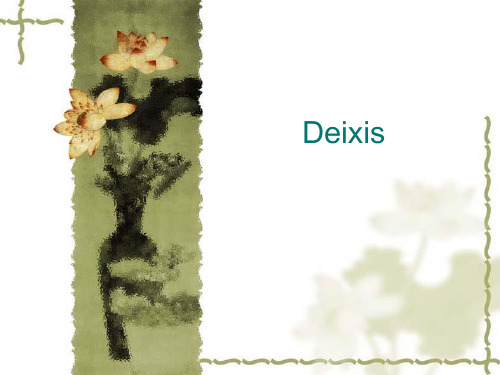
Eg. We can illustrate the distinction by taking the word “there”. It has all three uses. Its gestural use can be seen in a sentence like,’ I want you to put it there’. You have to know where the speaker is pointing in order to know what place he is indicating. The symbolic use is exemplified in the telephoner’s utterance, “ Is Johny there?” This time we understand the word “there” as meaning “ in the place where you are.” An example of the anaphoric use of “ there” is a sentence like “ I drove the car to the parking lot and left it there.” In that case the word refers to a place which had been identified earlier in the discourse, namely the parking plot(C.Fillmore,1997).
There is the speaker of the utterance, the sender of the message,what grammarians call the “first person”; there is, secondly, the addressee of the message or utterance, the message’s intended recipient, what we usually refer to as the “second person”; there is a third category of person deixis which plays a role of the intended audience. Other individuals referred to in sentences can be identified negatively with respect to these categories as being, for example, somebody who is neither speaker nor addressee, or somebody who is neither speaker nor addressee nor audience(C.Fillmore,1997).
指称、指别、指谓
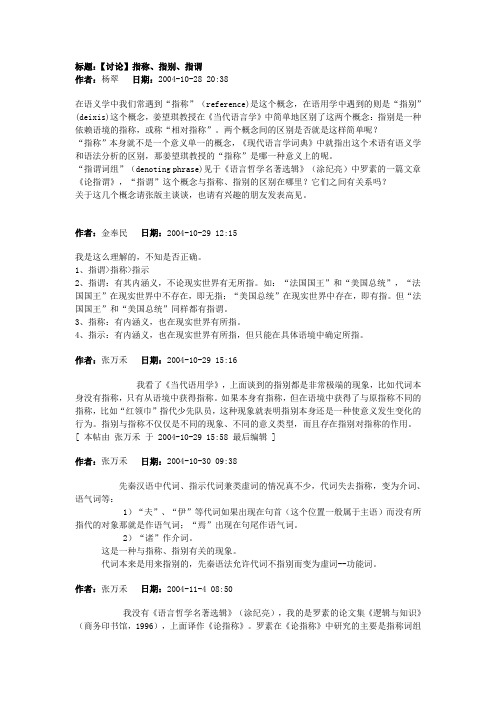
标题:【讨论】指称、指别、指谓作者:杨翠日期:2004-10-28 20:38在语义学中我们常遇到“指称”(reference)是这个概念,在语用学中遇到的则是“指别”(deixis)这个概念,姜望琪教授在《当代语言学》中简单地区别了这两个概念:指别是一种依赖语境的指称,或称“相对指称”。
两个概念间的区别是否就是这样简单呢?“指称”本身就不是一个意义单一的概念,《现代语言学词典》中就指出这个术语有语义学和语法分析的区别,那姜望琪教授的“指称”是哪一种意义上的呢。
“指谓词组”(denoting phrase)见于《语言哲学名著选辑》(涂纪亮)中罗素的一篇文章《论指谓》,“指谓”这个概念与指称、指别的区别在哪里?它们之间有关系吗?关于这几个概念请张版主谈谈,也请有兴趣的朋友发表高见。
作者:金奉民日期:2004-10-29 12:15我是这么理解的,不知是否正确。
1、指谓>指称>指示2、指谓:有其内涵义,不论现实世界有无所指。
如:“法国国王”和“美国总统”,“法国国王”在现实世界中不存在,即无指;“美国总统”在现实世界中存在,即有指。
但“法国国王”和“美国总统”同样都有指谓。
3、指称:有内涵义,也在现实世界有所指。
4、指示:有内涵义,也在现实世界有所指,但只能在具体语境中确定所指。
作者:张万禾日期:2004-10-29 15:16我看了《当代语用学》,上面谈到的指别都是非常极端的现象,比如代词本身没有指称,只有从语境中获得指称。
如果本身有指称,但在语境中获得了与原指称不同的指称,比如“红领巾”指代少先队员,这种现象就表明指别本身还是一种使意义发生变化的行为。
指别与指称不仅仅是不同的现象、不同的意义类型,而且存在指别对指称的作用。
[ 本帖由张万禾于 2004-10-29 15:58 最后编辑 ]作者:张万禾日期:2004-10-30 09:38先秦汉语中代词、指示代词兼类虚词的情况真不少,代词失去指称,变为介词、语气词等:1)“夫”、“伊”等代词如果出现在句首(这个位置一般属于主语)而没有所指代的对象那就是作语气词;“焉”出现在句尾作语气词。
deixis语言学定义

deixis语言学定义在语言学中,deixis是指用于指示特定人、物、地点、时间等的语言现象。
它是通过语言中的指示词或词组来实现的,例如代词、副词等。
deixis在日常交流中非常常见,它帮助我们在交流中理解和表达具体的参照点。
本文将介绍deixis的定义、分类以及在语言中的应用。
我们来介绍deixis的定义。
deixis是源于希腊语的一个词,意为“指示”。
在语言学中,deixis指的是通过上下文和特定的语言标记来指示特定的人、物、地点、时间等。
通过deixis,人们能够在交流中准确地理解和表达特定的参照点。
deixis可以根据指示的内容进行分类。
根据指示内容的不同,deixis可以分为人称deixis、空间deixis和时间deixis。
人称deixis是指用于指示与交流参与者相关的人物。
在人称deixis中,我们常用的代词如“我”、“你”、“他”等可以帮助我们指示特定的人。
空间deixis是指用于指示特定的地点或位置的语言现象。
例如,我们常用的副词如“这里”、“那里”等可以帮助我们指示特定的地点。
时间deixis是指用于指示特定的时间的语言现象。
例如,我们常用的时间状语词如“现在”、“昨天”、“明天”等可以帮助我们指示特定的时间。
除了以上分类,deixis还可以根据指示的方式进行划分。
根据指示方式的不同,deixis可以分为直接deixis和间接deixis。
直接deixis是指通过具体的语言标记来直接指示特定的参照点。
例如,代词“我”、“你”等直接指示特定的人。
间接deixis是指通过上下文信息来间接指示特定的参照点。
例如,当我们说“昨天我去了那里”,虽然没有明确指出“那里”的位置,但通过上下文信息,我们可以推断出“那里”是指昨天我们去过的地方。
在实际的交流中,deixis起着非常重要的作用。
通过deixis,我们可以使交流更加具体和准确。
然而,deixis也存在一些挑战,因为它的理解和表达都依赖于上下文和语境。
语用学 deixisppt课件

Deixis
指 示 语
1
1. What is Deixis?
1) Knowledge is power. 2) I am the British Prime Minister. 3) The President met the British Prime
2
1.2 Defining Deixis
A technical term from Greek, meaning “pointing” via language.
Any linguistic form used to accomplish this “pointing” is called a deictic expression, which is also called an indexical.
(1)你想在事业上取得成功,你就必须
下一番苦功夫。
(2)他那刻苦钻研的精神你不能不佩服
。
(3)这个人性格内向,不善表达,你问
他十句,他才答你一句。
13
Place deixis: The encoding of temporal points or
spans relative to the location of the speaker Proximal: here Distal: there
5
Deictic expressions include definite noun phrases, personal pronouns, demonstratives, adverbs, tenses, etc.
Person deixis

偏离中的常情-人称指示语在语用环境下的非常规用法摘要:指示语是语言学中的一种常见现象,是语言和语境之间关系最明显最直接的语言反映,指示语的偏离常规的用法反映了语用环境下指示语的转指或移指所能体现的语用效果.本文列举了5种特殊语境下的用法来说明人称指示词的这种特殊用法。
Abstract: Deixis is a popular linguistic phenomenon which reflects the relationship between the language and context. Personal deixis is particular in its normal use ,while in specific context , the rule for using them often is broken to realize the emotional function .关键词:语境语用人称指示语礼貌情感指示词是一种常见的语言现象,它反映了语言和语言系统中语境的关系,被认为是语言和语境之间关系最明显最直接的语言反映,是连结语义学和语用学的关节点。
指示词的使用表面上的简单掩盖了它真实的复杂性。
Deixis一词来自希腊语,意为指点(pointing)或标示(indicating)。
它唯一的两个子类是人称指示词和指示代词。
但是现在使用的指示词涵盖了更广的范围,包括指示副词和时态的语法范畴。
指示语(deixis)直接涉及语言结构和语境之间的关系。
语言中指示词语的指称和它们在构成语句时的含义,往往取决于话语的语境和说话人的信念和意图。
话语和语境之间的关系正是通过指示语而得以在语言结构上反映出来。
指示词大约有五类,但是传统上来讲只有三类:人称代词,像“you” “I” ; 时间指示词“now”“then”,空间指示词“here”“there”等等,其中人称指示词在人类的交往和语言中发挥着重要的作用。
deixis先用现象
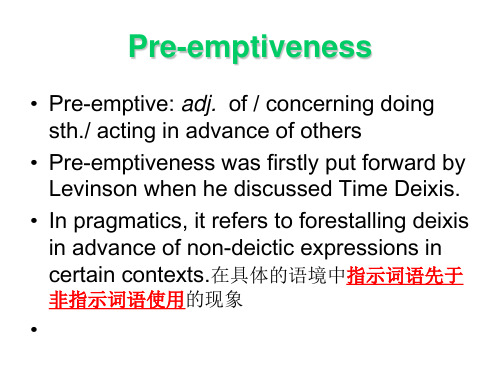
(additional information) • deictic field: 指示域 ground over which the pointing act is understood to extend. • In the concrete case, the deictic field is spatial and ranges from the immediate perceptual present to vast regions describes in acts of pointing to distant locales. • In the abstract case, the ground takes on non-spatial meanings. Bühler (1982).
非指示词语使用的现象
•
•
先用现象涉及语言使用者在使用指示词 语时的一种心理趋势,即言语参与者对处 于言语指示域内的人、事物、地点和时间 优先使用指示词语 (Levinson,1983)。 • 指示域:
• 相对应的汉语表达方式有: 先用现象、先用用法(pre-emptive usage张权); 先用权(pre-emptiveness 沈家煊); 先用性(pre-emptive严辰松、高航)。
先用权的消失
• 指示词语的先用现象是指在言语活动中谈及处于 指示域内的人、事、物、时间和地点时,人们通常 习惯于使用指示词语来表示。 • 这些指示词语对于其它可能与之有相同所指的非 指示词语有心理上的排斥作用,在指示语境中使用 时往往具有优先权。 • 但是在一些特殊的语境和语体中,存在用非指称 的称名取代指示词语指称的现象,这种现象称为 反先用现象(anti-preemptive usage),即先用作用 消失了。
2语用学指示语
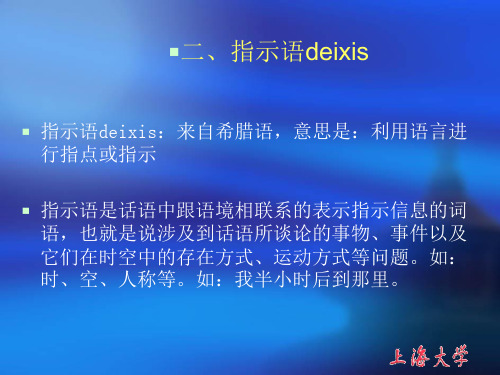
b. 第二人称: 你班上多少人。(你们)两者可替换。
c、第三人称: 这两个男女却放他不得。(他们)
(2)复数人称形式表单数
a. 第一人称: 咱们是个计算机盲,不会拔弄那玩意儿。(我 ) 上次我们讲了语言的起源,今天接着讲语言的 发展。 在文学中,我们提出……(我) 我们那口子(我)。 我们抽烟,不小心把被子烧着了。(我)
二、指示语deixis
指示语deixis:来自希腊语,意思是:利用语言进 行指点或指示
指示语是话语中跟语境相联系的表示指示信息的词 语,也就是说涉及到话语所谈论的事物、事件以及 它们在时空中的存在方式、运动方式等问题。如: 时、空、人称等。如:我半小时后到那里。
指代词
(deictics)
小姐,我要 那个杯子。
性是自然语言固有的、不可避免的特性;人们所讲 的90%以上的陈述句都包括说话人、听话人、时间、 地点等指示信息,如i、you、this、here、now、 yesterday等,只有获知类似词语的指示内容之后, 才能完整理解话语语义。
(一)指示语的特征 指示语有两个基本特征:(1)是指示语的具体所指
人称指示的变数用法
人称指示存在单数与复数形式,在使用中可 以用单数形式表示复数意义,也可用复数形 式表示单数意义。包括:我、你、他、她、 它。
(1)单数形式表复数
a. 第一人称:出现的语用条件?语用功能? 走,咱今晚看电影去(咱们) 还我河山(我们) 你大国敢不仁,我小国敢不义!(你们、我们 ) 今后七年,我花300亿美元引进210项重大技术 项目(我们)。 我外交部,我后方基地。指说话人所在一方。 (正规场合,存在对立双方)
1.人称指示语person deixis
用以表示说话人、听话人或第三者的词语或结构。 1、成员
语用学Deixis

• (5) Social deixis: honorifics敬语 (forms
to show respect such as Professor Li)
• Big Sale Tomorrow.
• Deixis belongs to pragmatic study
since it reveals a very close relationship between language and context.
Deixis
CONTENT
• Exercise
• The notion of deixis
• Deictic usage VS non-deictic usage
• Different usages of deictic terms
EXERCISE
• a. Flying planes can be dangerous.
• Flying planes can be planes that are flying.飞行 中的飞机是危险的。 • To fly the plane is a dangerous behavior.飞飞机 是一件危险的事。
• b. Shooting of hunters is cruel.
• Shooting animals is a cruel behavior. • Shooting hunters is a cruel behavior.
• c. It’s the taste.
• It’s the taste I like • It’s the taste I dislike.
NOTION
• Deixis, derived from Greek, means “show”, “point” or “indicate” in English.
deixis语言学定义
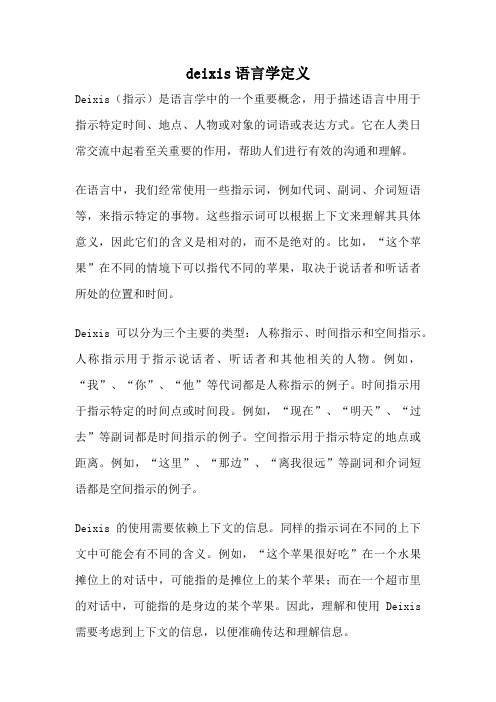
deixis语言学定义Deixis(指示)是语言学中的一个重要概念,用于描述语言中用于指示特定时间、地点、人物或对象的词语或表达方式。
它在人类日常交流中起着至关重要的作用,帮助人们进行有效的沟通和理解。
在语言中,我们经常使用一些指示词,例如代词、副词、介词短语等,来指示特定的事物。
这些指示词可以根据上下文来理解其具体意义,因此它们的含义是相对的,而不是绝对的。
比如,“这个苹果”在不同的情境下可以指代不同的苹果,取决于说话者和听话者所处的位置和时间。
Deixis可以分为三个主要的类型:人称指示、时间指示和空间指示。
人称指示用于指示说话者、听话者和其他相关的人物。
例如,“我”、“你”、“他”等代词都是人称指示的例子。
时间指示用于指示特定的时间点或时间段。
例如,“现在”、“明天”、“过去”等副词都是时间指示的例子。
空间指示用于指示特定的地点或距离。
例如,“这里”、“那边”、“离我很远”等副词和介词短语都是空间指示的例子。
Deixis的使用需要依赖上下文的信息。
同样的指示词在不同的上下文中可能会有不同的含义。
例如,“这个苹果很好吃”在一个水果摊位上的对话中,可能指的是摊位上的某个苹果;而在一个超市里的对话中,可能指的是身边的某个苹果。
因此,理解和使用Deixis 需要考虑到上下文的信息,以便准确传达和理解信息。
除了上下文之外,语言使用者的背景知识和经验也会影响Deixis的理解和使用。
不同的语言和文化背景对Deixis的运用也可能存在差异。
例如,在一些语言中,空间指示更加重要,而在另一些语言中,时间指示更加重要。
因此,了解不同语言和文化背景对Deixis的运用习惯是学习和理解语言的重要一步。
Deixis在日常交流中起着至关重要的作用。
它帮助我们在沟通中准确定义时间、地点、人物和对象,使得交流更加准确和具体。
没有Deixis,我们将无法有效地指示和引用特定的事物,交流将变得困难和模糊。
因此,学习和理解Deixis对于语言学习者和研究者来说至关重要。
指示语“我们”与“咱们”的异同及其语用含义探析

指示语“我们”与“咱们”的异同及其语用含义探析汉语普通话中第一人称复数指示语有“我们”和“咱们”两种表达形式。
本文在汉语语料的基础上,对第一人称代词“我们”和“咱们”的由来、地域差异、语体差异、语用差别及其特殊语用含义等进行了分析对照,并对它们在具体应用中的特点进行了基本归纳。
标签:“我们” “咱们” 人称指示语语用含义一、引言指示语(deixis)是指在口语语篇或书面语篇中对某个人或某些人或事物进行指称的用语。
早在20世纪70年代初,Fillmore就已经对指示语做了较为系统的研究,将其分为人称、时间及地点指示语(何自然,1988)。
随后,Levinson (1983)对指示语做了更为全面而详细的阐述,按照指示功能将其划分为五大类,即人称、时间、地点、语篇和社交指示语,并且指出人称指示语是指谈话双方用话语来传达信息时的相互称呼,人称指示语的体系由第一人称、第二人称和第三人称构成。
目前,我国学者对人称指示语的研究基本参照国外的相关理论,但对汉语语料中人称指示语的分析研究已经取得了一些成果。
近年来,许多学者从语用学的角度对指示语进行了探讨。
陈令君、马坤(2006),潘福刚(2007),赖彦(2007)等从人称指示语的语用及交际功能方面进行了研究;古伟霞(2005)從礼貌功能角度进行了探讨;李永(2003)对汉语人称代词的发展进行了分析和展望;郭启平(2008)对汉语的个别人称代词做了专门讨论。
然而,我国学者对汉语人称指示语“我们”和“咱们”在实际使用中语用含义的异同研究还不够全面。
本文在分析汉语语料的基础上,对“我们”和“咱们”进行语义、语用方面的比较分析,探讨两者之间的异同以及这些异同点的语用特征及规律。
二、“我们”和“咱们”的由来(一)“我们”的由来表示第一人称的“我”最早见于甲骨刻辞中,表达的都是复数意义,相当于现代汉语中的“我们”。
例如:(1)师不余我见?(《甲骨文合集》)(2)乙丑其雨,不唯我祸。
Unit 6 Deixis
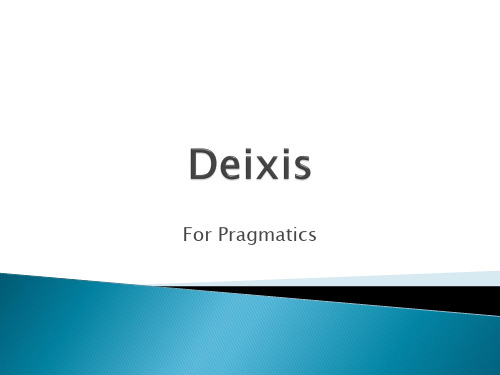
Inference of deictic information depends much on the analysis of the context of speaking. For example: I like playing basketball. This color is suitable for you. Xiao Hua will be in New York next month. I in (1) refers to its speaker, so different speakers of the sentence will result in different referents of I. The deictic information of this and you in (2) also varies with the context: this might refer to red, green, white, black or a color of another sort, depending on which happens to be in the presence of the speaker; the referent of you varies with the identity of the addressee. Interpretation of the deictic information n the time of speaking, which is also a context-dependent variant.
指示语的翻译

人称指示的翻译
人称指示的分类:第一人称指示,包括说话者;第二人 称指示,包括受话者;第三人称指示,既不包括说话者, 也不包括受话者,第三人称指示一般不是谈话的参加者, 但通常和交际双方,或其中一方有密切关系,在特定场 合甚至会来借指说话者或受话者。 第一人称指示语有单数和复数两种,如果指示语以复数 形式出现在话语中,在英汉两种语言中均有可能出现两 种情况:其一,包括受话者(we-inclusive-of-addressee); 其二,不包括受话者(we-exclusive-of-addressee) ,examples:
e.g. I am sorry to inform you that there are no vacancies on the French tour due to start on Saturday 10th July. But we’ll send you an application form. If you will complete it and return it to me,I shall be pleased to your daughter’s name to our waiting list. Here,it is a very formal notice,in which it is not appropriate to translate “you” into “你”directly. So it can be translated like this:
地点指示的翻译
在英语中,地点指示语传递的信息直接受语境影响,不 仅包括直接语境而且包括间接语境,两者固然都很重要, 但对于不在场的间接受话者,译者更为关注的应是后者。 因为对于说话者和受话者而言,话语中某些地点指示语 的手势用法和象征用法(symbolic usage)的确切信息可 凭借各自所处的方位和空间而定。但对于不在现场的译 者而言却暗含于间接语境之中。
- 1、下载文档前请自行甄别文档内容的完整性,平台不提供额外的编辑、内容补充、找答案等附加服务。
- 2、"仅部分预览"的文档,不可在线预览部分如存在完整性等问题,可反馈申请退款(可完整预览的文档不适用该条件!)。
- 3、如文档侵犯您的权益,请联系客服反馈,我们会尽快为您处理(人工客服工作时间:9:00-18:30)。
Chapter Two Deixis1. What is deixis?1.1 Examples for analysisa) Knowledge is power.b) I am the British Prime Minister.c) The President met the British Prime Minister there yesterday.Questions: Can truth-conditional semantics account for these three sentences equally well? If not, what are the differences between them?1.2 Defining deixis● A technical term from Greek, meaning "pointing" via language.Any linguistic form used to Accomplish this "pointing" is called a deictic expression, which is also called an indexical.A deictic expression is used to indicate, something in the immediate context. Soa deictic expression encodes information in context (Yule, 1996).●Deictics are expressions whose interpretations make essential reference to certainaspects of their contexts of utterance, including the role of participants in the speech event and their spatio-temporal and social location.To put it simply, those expressions whose meaning cannot be fully understood without reference to the context in which they' are uttered, or whose references depend critically on the context in which they are uttered (Levinson, 1983).●Deixis can be classified into different types:Person deixis: me, you, etc.Spatial/place deixis: here, there, etc.Temporal/time deixis: now, then, etc.Others termed discourse deixis (that. this), social deixis (tu, vous)●Deictic expressions including definite noun phrases, personal pronouns,demonstratives, adverbs, tenses, etc. According to Bar-Hillel (1954) "Indexical Expressions", more than 90% of the declarative sentences people utter are indexical (involving' implicit references to the speaker, addressee, time, and place in expressions).2. Pragmatic description2.1 Categories used to describe deixis●Person deixis: the role of participants1st person: the speaker2nd person: the addressee3rd person: third party (neither the speaker nor the addressee)●Place deixis: the encoding of spatial locations relative to the location of thespeakerProximal: hereDistal: there●Time deixis: the encoding of temporal points or Spans :selative to the time ofspeaking (the coding time as opposed to the receiving time)Proximal: nowDistal: thenProximal: present tensesDistal: past tenses●Discourse deixis: the encoding of reference to portions of the unfolding discourse:That is what I want to know.●Social deixis: tu/vous distinction in French; ni/nin Chinese2.2Characteristics of deixis●All deictic expressions depend, for their interpretation, on the speaker and thehearer who share the same context. In face-to-face expression, deixis seems more tied to the speaker’s context. This is because the speaker expresses his ideas about the world from his personal point of view.●Therefore deictic expressions have basic distinctions between being "nearspeaker" and "distant from speaker" or "away from speaker".●The deictic center: Deixis has to be interpreted in terms of the speaker's location,or the deictic center which means that the speaker organizes messages from his personal point of view. This can be understood as egocentric.CB CBA B CThe model by Gisa Rauh (1983)The deictic system:A: the coding timeB: in connection with the coding timeC: not in connection with the coding time●The deictic projection (shifts in points of view, Fillmore, 1975)The speaker speaks as if the central person were the hearer, the central time were the time the hearer received the utterance and the central place were the hearer's location rather than the speaker’s location.Dad will play with you. (talking to his baby)I've gone to the post office and will be back soon. (the left message on the door)I was looking at this little puppy in a cage with such a sad look on its face. It waslike, "Oh, I'm so unhappy here, will you set me free?"(The direct speech represents the feeling of the speaker)●An account of the ego-centric nature of deixisWhy is deixis ego-centric in nature?Signal receivedtransmitted signalX transmitter channel receiver Ysource of noiseA model of communication by Lyons (1977)Two points:a.The role of the encoder and the decoder, especially the role of the encoder(encoding from his perspective);b.The relation established between ego and non-ego in the organization of themessage at different dimensions.●Deictic and non-deictic usagesExamples:a.You can vacuum while you wash the dishes, and – keep your hat on – I'll get thegroceries.b.I have been monitoring activities on Earth for some time, and have sent aninvasion force disguised as trucks there to control widespread corruption.c.We're supposed to see Dr. Gesundheit today, but Sandy refuses to go there unlessshe gets a balloon.d.Ok, this will prove that Eks is irresponsible: when we were on a committeetogether, he felt asleep during every meeting that he managed to attend.e.Put that in the wastebasket, please.f.The dean expelled John because he discovered his secret.g.Before he got out of bed, James decided that today would be a good day to leavefor Crisfield.h.How did you enjoy your trip?i.I cut finger: this one.j.I am enjoying life here in Nottingham.k.Sandy wants to go to the park, but doesn't know now to get there.●Deictic usage: revolving a relation between an object in the world and alinguistic form with no semantically determined reference (the form X is used to refer to A, the reference is determined in the discourse)Non-deictic usage: involving relations between such a form and some other linguistic expression (the form X is used to the same thing "as its antecedent;coreferential relations)gesturaldeictic usage anaphoriccataphoricDeictic expressionsanaphoricnon-deictic usagecataphoricAttributive and referential usesAttributive use: refer to an entity that is known to the speaker only in terms of its descriptive properties as in He wants to marry a woman with lots of money.Referential use: refer to an entity that the speaker actually has in mind as in There is a man waiting for you.Ambiguity: Smith's murderer is insane. (attributive or referential?)。
